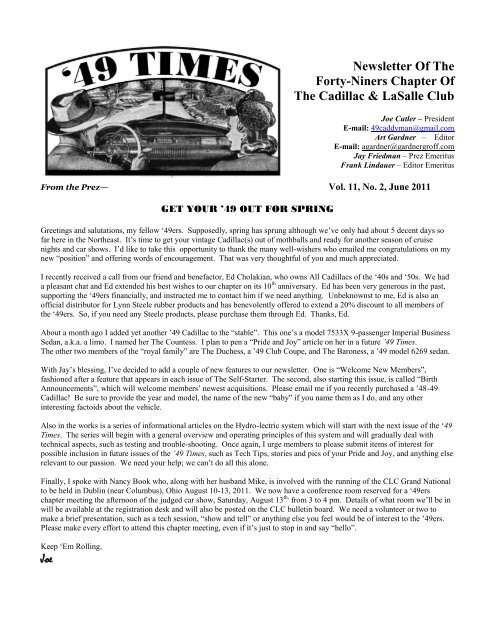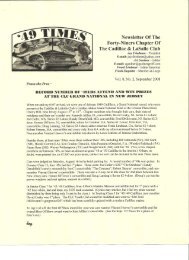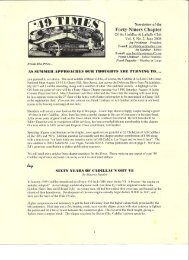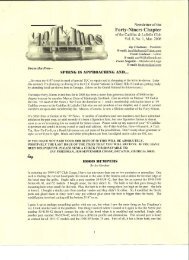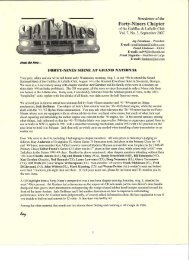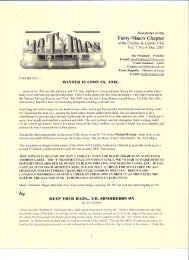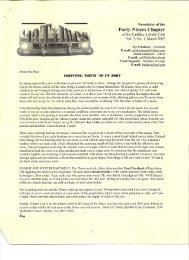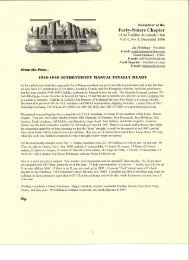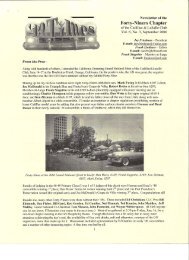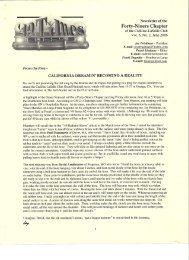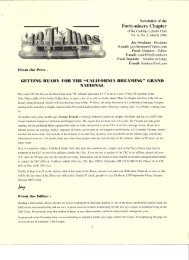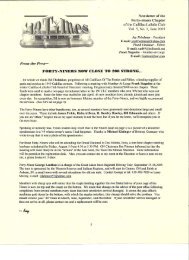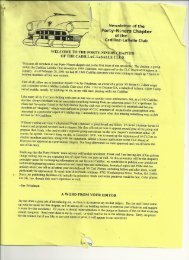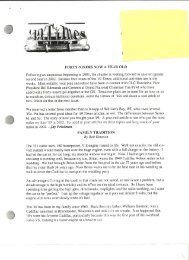Create successful ePaper yourself
Turn your PDF publications into a flip-book with our unique Google optimized e-Paper software.
Newsletter Of The<br />
Forty-Niners Chapter Of<br />
The Cadillac & LaSalle Club<br />
Joe Cutler – President<br />
E-mail: 49caddyman@gmail.com<br />
Art Gardner – Editor<br />
E-mail: agardner@gardnergroff.com<br />
Jay Friedman – Prez Emeritus<br />
Frank Lindauer – Editor Emeritus<br />
From the Prez— Vol. 11, No. 2, June <strong>2011</strong><br />
GET YOUR ’49 OUT FOR SPRING<br />
Greetings and salutations, my fellow „49ers. Supposedly, spring has sprung although we‟ve only had about 5 decent days so<br />
far here in the Northeast. It‟s time to get your vintage Cadillac(s) out of mothballs and ready for another season of cruise<br />
nights and car shows. I‟d like to take this opportunity to thank the many well-wishers who emailed me congratulations on my<br />
new “position” and offering words of encouragement. That was very thoughtful of you and much appreciated.<br />
I recently received a call from our friend and benefactor, Ed Cholakian, who owns All Cadillacs of the „40s and „50s. We had<br />
a pleasant chat and Ed extended his best wishes to our chapter on its 10 th anniversary. Ed has been very generous in the past,<br />
supporting the „49ers financially, and instructed me to contact him if we need anything. Unbeknownst to me, Ed is also an<br />
official distributor for Lynn Steele rubber products and has benevolently offered to extend a 20% discount to all members of<br />
the „49ers. So, if you need any Steele products, please purchase them through Ed. Thanks, Ed.<br />
About a month ago I added yet another ‟49 Cadillac to the “stable”. This one‟s a model 7533X 9-passenger Imperial Business<br />
Sedan, a.k.a. a limo. I named her The Countess. I plan to pen a “Pride and Joy” article on her in a future ’49 Times.<br />
The other two members of the “royal family” are The Duchess, a ‟49 Club Coupe, and The Baroness, a ‟49 model 6269 sedan.<br />
With Jay‟s blessing, I‟ve decided to add a couple of new features to our newsletter. One is “Welcome New Members”,<br />
fashioned after a feature that appears in each issue of The Self-Starter. The second, also starting this issue, is called “Birth<br />
Announcements”, which will welcome members‟ newest acquisitions. Please email me if you recently purchased a ‟48-49<br />
Cadillac! Be sure to provide the year and model, the name of the new “baby” if you name them as I do, and any other<br />
interesting factoids about the vehicle.<br />
Also in the works is a series of informational articles on the Hydro-lectric system which will start with the next issue of the „49<br />
Times. The series will begin with a general overview and operating principles of this system and will gradually deal with<br />
technical aspects, such as testing and trouble-shooting. Once again, I urge members to please submit items of interest for<br />
possible inclusion in future issues of the ’49 Times, such as Tech Tips, stories and pics of your Pride and Joy, and anything else<br />
relevant to our passion. We need your help; we can‟t do all this alone.<br />
Finally, I spoke with Nancy Book who, along with her husband Mike, is involved with the running of the CLC Grand National<br />
to be held in Dublin (near Columbus), Ohio August 10-13, <strong>2011</strong>. We now have a conference room reserved for a „49ers<br />
chapter meeting the afternoon of the judged car show, Saturday, August 13 th, from 3 to 4 pm. Details of what room we‟ll be in<br />
will be available at the registration desk and will also be posted on the CLC bulletin board. We need a volunteer or two to<br />
make a brief presentation, such as a tech session, “show and tell” or anything else you feel would be of interest to the ‟49ers.<br />
Please make every effort to attend this chapter meeting, even if it‟s just to stop in and say “hello”.<br />
Keep „Em Rolling,<br />
Joe
WELCOME NEW MEMBERS<br />
The „49ers Chapter extends its most cordial welcome to the following new members:<br />
Roy Asbahr Gresham, Oregon 1949 Coupe De Ville<br />
Carlos Duval Pirque, Chile 1949 6207 Club Coupe<br />
Bruce Duykers Sandpoint, Idaho 1949 6169 Sedan<br />
Tony Ebejer Victoria, Australia 1949 Convertible (RH Drive!), 1949 Club Coupe<br />
John Mollere Ponchatoula, Louisiana 1949 6207 Club Coupe<br />
Jon Yinger Brea, California Two (2) 1949 60 Specials<br />
BIRTH ANNOUNCEMENTS<br />
April 4 th : A bouncing baby girl (a very LARGE one at that!) was delivered on this date to Joe Cutler, of Douglas, Mass.<br />
Named The Countess, she is a 1949 model 7533X 9-passenger Imperial Business Sedan. Dad and daughter are doing fine.<br />
April: A new baby, a 1949 model 6169 4-door sedan, was delivered to Mr. and Mrs. Bruce Duykers of Sandpoint, Idaho. This<br />
is the proud parents‟ first Cadillac and they‟re enthralled with Her / Him?.<br />
Congratulations on the new arrivals.<br />
IT WORKS FOR ME: 8 VOLTS SOLVES THE 6 VOLT STARTING PROBLEMS<br />
By Dick DeVito<br />
After reading the article in the March ‟11 Times on 6 volt battery problems, I thought I‟d share with everyone how I solved the<br />
problem. I put in an 8 volt battery. Everything stays the same. The voltage regulator is re-set to 8.6 volts, which is enough to<br />
do the job. All the bulbs are ok and when I tell her to start it sounds just like a 12 volt system. I had the same problem on a<br />
1948 Lincoln V12 which 8 volts fixed. I‟m sure there will be much controversy, but it works for me. RADSR@PNPCO.COM<br />
DROOPING DRIVER’S DOOR HANDLE REDUX<br />
By Jay Friedman<br />
We‟ve touched upon this problem in past issues of the Times, but there‟s always new information coming to hand. Drooping<br />
door handles, particularly that of the driver‟s door which gets more use, is an annoying problem on ‟48 and ‟49 Cadillacs.<br />
Referring to the photo on the next page of a front latch, it is caused by the door handle‟s square steel shaft that goes inside the<br />
door to enter the square opening in a softer pot metal piece in the latch called the tumbler, indicated by Arrow A.
1948 -1949 CADILLAC FRONT DOOR LATCH<br />
Over the years, constant use causes the square opening in the tumbler to become partially rounded, resulting in the weight of<br />
the handle causing it to droop. (Arrow B points to the hole in the tumbler for the door handle set screw and Arrow C to the<br />
lock plate controlled by the outside key lock.)<br />
There are several fixes, as set forth in the next paragraph, all of which, unfortunately, require removing the door panels and<br />
getting into the innards of the door. Though this is a lengthy job, as lots of screws must be unscrewed and lots of parts<br />
removed, unless you have to deal with taking apart the door latch itself it is not technically difficult. (The larger arrows in the<br />
photo point to two difficult-to-deal-with springs in the mechanism that must be removed and replaced when taking apart the<br />
latch.) Note that convertibles and Coupe de Villes have different door latches than club coupes and sedans. The above photo<br />
comes from the 1948 Fisher "C" Body Manual for Cadillacs and Oldsmobile 98s, which has excellent, well written, illustrated<br />
step-by-step procedures for doing this type of work. They can usually be found on Ebay and I suggest you buy one.<br />
1. The best fix is to find another door latch in better or new condition. This way you avoid taking apart the latch which, as<br />
mentioned above, can be tricky. I once lucked out at a flea market and found a brand new '49 Buick driver's door latch for a<br />
club coupe (such as mine) or a sedan. 1949 Buick Supers and Roadmasters as well as '48 and 49 Oldsmobile 98s used the<br />
same door latch as '48 and 49 Cads. In my experience Buick and Olds parts frequently sell for less than the identical Cadillac<br />
parts, so you can try dealers that sell stuff for those cars. I was recently told that in the 1948 version of the latch the tumbler is<br />
made of bronze, which is much more durable than the‟49 pot metal tumbler.<br />
2. If the car is a convertible or Coupe de Ville, '49er Ron Brooks of Twin Lake MI makes a sturdier tumbler to replace the<br />
original pot metal tumbler, which he sells for $125 or so. His phone number is 231-821-2812.<br />
3. For other models of ‟48 or '49 Cadillac, All Cadillacs of the „40s and „50s www.allcads.com sells a sturdier replacement<br />
tumbler for $50 or so.<br />
While both of the above are excellent replacement parts which are far superior to the original part, as mentioned above<br />
removing the latch from the door then installing the new part is not easy and requires much patience.
GEORGE RUBENSON’S SERIES 61 SEDAN AT HOME IN SALISBURY, MARYLAND<br />
’49 CADILLAC DIMENSIONS II<br />
Chapter member Robert Robin sent us a series of engineering drawings a ‟49 Cadillac Club Coupe exterior dimensions in<br />
inches (not to scale), the front view of which appeared in the June 2007 Times. Below is a left side view.
GETTING YOUR BRAKES’ HYDRAULIC SYSTEM IN SHAPE<br />
OR<br />
STOPPING IS MORE IMPORTANT THAN GOING<br />
By Art Gardner<br />
Many of you are aware of the tendency these days to "update" the car's brakes with disk brakes in an effort to make the car<br />
safer. In my opinion, the biggest danger with the original 1949 Cadillac brakes is the lack of a second circuit, not raw stopping<br />
power. Up through 1961, I think, the brakes were all single circuit. Certainly in 1949 they were single circuit. That means<br />
that if you pop a line or hose or wheel cylinder anywhere on the car, you will lose ALL brakes all at once. Dual circuit brakes,<br />
which I think started with the 1962 Cads, eliminate that risk and leave you with either front or rear brakes in the event of a<br />
calamity. Many people will say, but "hey, I have never had a problem, so why change anything." But when you do have a<br />
problem, this is a BIG problem.<br />
So, the most important thing, in my opinion is to make sure the original parts are PERFECT, especially the metal lines. Brake<br />
fluid is hydrophilic, meaning it attracts moisture (right out of the air). The water that gets in the lines in this way rusts the<br />
metal lines from the inside out. They can look perfectly normal in a visual inspection, but be rusting away on the inside. One<br />
day a pinhole pops though and you lose all brake pressure. This happens more regularly than you might think, which is why<br />
the government eventually outlawed single circuit brakes. This fluid-borne rust is also how your wheel cylinders and master<br />
cylinder get pitted. The fix is to replace the plain metal lines with stainless steel lines. Put on all new hoses. Sleeve the wheel<br />
cylinders and the master cylinder with brass or stainless steel. Flush out the brake fluid and replace it with new fluid every 2-3<br />
years. Do that and the original drum brakes should be safe for a long time!<br />
If you want to make them even safer, you can put in a dual circuit master cylinder. It takes some extra work and plumbing, but<br />
to me it is worth it for the additional peace of mind. This is what I did with my last „49 6107 Club Coupe and am doing it to<br />
my new „49 coupe. I developed a nice kit for installing such in the original mounting place on the frame, so everything looks<br />
great and works correctly. I haven't worked out how to do this on my 1956 Series 60 Fleetwood, but I am still noodling on it<br />
(as there is precious little room at the front of the 56 power brake booster for a dual circuit master).<br />
I tried a disk brake "kit" on my last 49 and it was a disaster. I never did get it to work right, so I gave up and went back to the<br />
reliable drum brakes (augmented by my dual circuit master kit using a modern Wilwood dual circuit master).<br />
I drive my old Cadillac's as daily transportation. Right now, I use the '49 fastback in the cold months (it is black and has no air<br />
conditioning) and use the '56 60S in the warm months (its factory air works great). So I am relying on my good old drum<br />
brakes every day to stop my cars and keep me safe.<br />
If you use the car only occasionally, such as for club events a few times per year, you might feel less motivated to be so finicky<br />
about brakes and might be tempted to do the minimum, instead of the maximum, in restoring the brakes. I can understand that<br />
tendency. But keep in mind that, as the song says, rust never sleeps and the corrosion inside the lines and the cylinders<br />
continues whether you use the car or not. So you can still have a safety issue with the brakes, even if you only use the car a<br />
few times per year.<br />
If you keep the single master, but make the entire system perfect, you should be okay. A dual circuit master is a nice peace of<br />
mind as an extra safety measure, but you should be okay without it if everything else is right.<br />
TECH TIP: ’49 CADILLAC SPARK PLUGS<br />
Early ‟49 Cadillacs used AC 48 spark plugs, a very “hot” plug. The difference between hot and cold spark plugs is how<br />
quickly the plug body dissipates heat. Hot spark plugs dissipate heat slowly, keeping its temperature higher, which allows the<br />
plug to burn off harmful carbon deposits quickly. They are used in cars that are usually driven slowly and in stop and go<br />
traffic, whose motors frequently don‟t get fully warmed up. When designating the spark plug for the new „49, Cadillac<br />
engineers thought most of them would be used under such conditions, but apparently this turned out not to be the case as the<br />
following 1949 Cadillac factory “Serviceman‟s Supplement” explains:
So, to be absolutely authentic either AC 48 or 46-5 spark plugs can be used in early motors, but only 46-5s should be used in<br />
motors from number 31,613. Nonetheless, NOS AC 48 plugs seem to be more easily found today. Also, your motor may need<br />
a hotter plug anyway if you don‟t drive much at high speeds, so you may want to stick with them. And, between us „49ers,<br />
how many cars show judges would know this obscure factoid anyway?<br />
MYSTERY: WHY DID ART GARDNER (2 ND FROM RIGHT) NEED 7 SUPERVISORS<br />
WHEN HE RECENTLY PUT FLUID IN A ‘49’s REAR SHOCK ABSORBERS?
ONE PAGE MINI SHOP MANUAL<br />
By Jay Friedman<br />
Speaking of spark plugs, have you ever been engrossed in cleaning them and when it came time to set their gaps could not for<br />
the life of you remember how many thousandths of an inch was correct? A ‟49 shop manual has all this sort of information,<br />
but that means getting out the manual and turning pages with your greasy hands until you come to the right place. Why not<br />
have all your „49‟s specs and similar info set forth on one or two pages you can quickly refer to? I recently came upon the<br />
following sheet which has most of everything you need to know in the way of specifications when working on a ‟49 and it is<br />
now posted on a wall in my garage. Cut it out and hang it up if you think you‟ll find it useful too.
Joe Cutler<br />
108 Monroe Street<br />
East Douglas MA 01516


